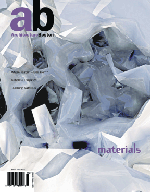
copyright 2006 Architecture Boston magazine, Boston Society of Architects
The elusive and unassuming Robert Campbell, Boston’s homegrown architectural critic, hosted a glittering night at the Museum of Fine Arts in tweed. He sat on the stage opposite Daniel Libeskind of WTC fame and bantered with the black-clad maestro in front of the hub’s benefactors, architects, educators, and intelligentsia. Campbell is one of the sharpest critics around, a Pulitzer recipient and an architect. Libeskind had been a paper architect for 30 years before he completed the remarkable Jewish Museum in Berlin (1999). He is the architect for the permanent home for the New Center for Arts and Culture (NCAC) to be built on the Rose Kennedy Greenway.
Three cheers to the NCAC visionaries who correctly wagered that an audience could handle an evening without pictures or PowerPoint. The sold out crowd came to hear a conversation between two quick wits coming from opposite sensibilities, a sort of speed repartee about everything architecture. The two discussed spectacle and representation, Libeskind’s virtuosity at the accordion, and the creative process. Libeskind spoke with a Polish accent at super sonic rate while smiling incessantly. His answers never precisely addressed the questions; like his architecture, his mind worked allegorically.
Case in point: Campbell noted Libeskind’s trademark cowboy boots—black with pointed toes—and the famous glasses that got New Yorkers sprinting to their opticians. Libeskind’s comeback, “I never do anything that doesn’t have a point” immediately warmed the audience to his eccentricities, but kept his inquisitor off the scent. Never straying, Campbell asked which was Libeskind’s favorite Boston building. His answer: the Paul Revere House in the North End. “But how,” asked Campbell incredulously, “could you love something that’s completely fake?” No matter, grinned his interviewee, it is a powerful place that provokes a deep sense of history. Fake or not, that’s where he would take his family first to drink up the spirit of the city.
When Campbell opened to questions, hands shot up everywhere. The questions revealed a thoughtful and educated audience. So architects should listen up: there is public interest in the conversations forming our built landscape, and you can leave your laptop at home. Listening to an architect freed from his renderings is like reading the book versus seeing the movie; Libeskind constructed his philosophy with wit and charm.